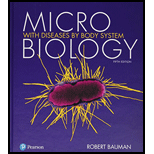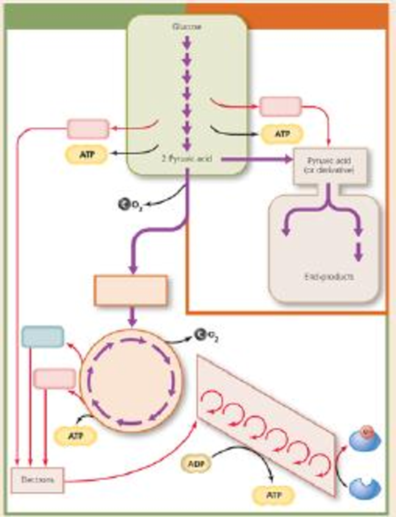
Microbiology with Diseases by Body System (5th Edition)
5th Edition
ISBN: 9780134477206
Author: Robert W. Bauman Ph.D.
Publisher: PEARSON
expand_more
expand_more
format_list_bulleted
Concept explainers
Textbook Question
Chapter 5, Problem 2VI
Label the diagram below to indicate acetyl-CoA, electron transport chain, FADH2, fermentation, glycolysis, Krebs cycle, NADH, and respiration. Indicate the net number of molecules of ATP that could be synthesized at each stage during bacterial respiration of one molecule of glucose.

Expert Solution & Answer
Want to see the full answer?
Check out a sample textbook solution
Students have asked these similar questions
When taking vitamins and vitamin-mineral supplements, how can one be sure they are getting what they are taking?
How many milligrams of zinc did you consume on average per day over the 3 days? (See the Actual Intakes vs. Recommended Intakes Report with all days checked.)
Enter the number of milligrams of zinc rounded to the first decimal place in the box below.
______ mg ?
the direct output from molecular replacement is a coordinate file showing the orientation of the unknown target protein in the unit cell. true or false?
Chapter 5 Solutions
Microbiology with Diseases by Body System (5th Edition)
Ch. 5 - How can oxidation take place in an anaerobic...Ch. 5 - Why do electrons carried by NADH allow for...Ch. 5 - Why does catabolism of amino acids for energy...Ch. 5 - An uninformed student describes the Calvin-Benson...Ch. 5 - Prob. 5TMWCh. 5 - Why is feedback inhibition necessary for...Ch. 5 - Breaks a large molecule into smaller ones a....Ch. 5 - Includes dehydration synthesis reactions a....Ch. 5 - Prob. 3MCCh. 5 - Prob. 4MC
Ch. 5 - Involves the production of cell membrane...Ch. 5 - Includes hydrolytic reactions a. anabolism only b....Ch. 5 - Includes metabolism a. anabolism only b. both...Ch. 5 - Prob. 8MCCh. 5 - A reduced molecule _________. a. has gained...Ch. 5 - Prob. 10MCCh. 5 - Coenzymes are ________. a. types of apoenzymes b....Ch. 5 - Which of the following statements best describes...Ch. 5 - Which of the following does not affect the...Ch. 5 - Most oxidation reactions in bacteria involve the...Ch. 5 - Under ideal conditions, the fermentation of one...Ch. 5 - Under ideal conditions, the complete aerobic...Ch. 5 - Which of the following statements about the...Ch. 5 - Reactions involved in the light-independent...Ch. 5 - The glycolysis pathway is basically __________. a....Ch. 5 - A major difference between anaerobic respiration...Ch. 5 - 1. _______ Occurs when energy from a compound...Ch. 5 - Fill in the Blanks 1. The final electron acceptor...Ch. 5 - Fill in the Blanks 2. Two ATP molecules are used...Ch. 5 - Fill in the Blanks 3. The initial catabolism of...Ch. 5 - Fill in the Blanks 4. ________ is a cyclic series...Ch. 5 - Fill in the Blanks 5. The final electron acceptor...Ch. 5 - Fill in the Blanks 6. Three common inorganic...Ch. 5 - Fill in the Blanks 7. Anaerobic respiration...Ch. 5 - Fill in the Blanks 8. Complete the following...Ch. 5 - Prob. 9FIBCh. 5 - Fill in the Blanks 10 The main coenzymes that...Ch. 5 - VISUALIZE IT! 1 Label the mitochondrion to...Ch. 5 - Label the diagram below to indicate acetyl-CoA,...Ch. 5 - Examine the biosynthetic pathway for the...Ch. 5 - Prob. 1SACh. 5 - Why we enzymes necessary for anabolic reactions to...Ch. 5 - How do organisms control the rate of metabolic...Ch. 5 - How does a nor-competitive inhibitor at a single...Ch. 5 - Explain the mechanism of negative feedback with...Ch. 5 - Facultative anaerobes can live under either...Ch. 5 - How does oxidation of a molecule occur without...Ch. 5 - List at least four groups of microorganisms that...Ch. 5 - Why do we breathe oxygen and give of carbon...Ch. 5 - Why do cyanobacteria and algae take in carbon...Ch. 5 - What happens to the carbon atoms in sugar...Ch. 5 - How do yeast cells make alcohol and cause bread to...Ch. 5 - Where specifically does the most significant...Ch. 5 - Why are vitamins essential metabolic factors for...Ch. 5 - A laboratory scientist notices that a cer1ain...Ch. 5 - Arsenic is a poison that exists in two states in...Ch. 5 - Explain why an excess of all three of the amino...Ch. 5 - Why might an organism that uses glycolysis and the...Ch. 5 - Describe how bacterial fermentation causes milk to...Ch. 5 - Giardia intestinalis and Entamoeba histolytica are...Ch. 5 - Two cultures of a facultative anaerobe are grown...Ch. 5 - What is the maximum number of molecules of ATP...Ch. 5 - In terms of its effects on human metabolism, why...Ch. 5 - Cyanide is a potent poison because it irreversibly...Ch. 5 - How are photophosphorylation and oxidative...Ch. 5 - Members of the pathogenic bacterial genus...Ch. 5 - Compare and contrast aerobic respiration,...Ch. 5 - Scientists estimate that up to one-third of Earths...Ch. 5 - A young student was troubled by the idea that a...Ch. 5 - If a bacterium uses beta-oxidation to catabolize a...Ch. 5 - Some desert rodents rarely have water to drink....Ch. 5 - Prob. 17CTCh. 5 - We have examined the total ATP, NADH, and FADH2...Ch. 5 - Explain why hyperthermophiles do not cause disease...Ch. 5 - In addition to extremes in temperature and pH,...Ch. 5 - Figure 5.18b illustrates events in aerobic...Ch. 5 - Suppose you could insert a tiny pH probe into the...Ch. 5 - Even though Pseudomonas aeruginosa and...Ch. 5 - Photosynthetic organisms are rarely pathogenic....Ch. 5 - Prob. 25CTCh. 5 - A scientist moves a green plant grown in sunlight...Ch. 5 - What class of enzyme is involved in amination...Ch. 5 - Using the following terms, fill in the following...
Knowledge Booster
Learn more about
Need a deep-dive on the concept behind this application? Look no further. Learn more about this topic, biology and related others by exploring similar questions and additional content below.Similar questions
- the direct output from molecular replacement is a coordinate file showing the orientation of the unknown target protein in the unit cell. true or false?arrow_forwardDid your intake of vitamin C meet or come very close to the recommended amount? yes noarrow_forwardWhich of the following statements about hydration is true? Absence of thirst is a reliable indication that an individual is adequately hydrated. All of these statements are true. Although a popular way to monitor hydration status, weighing yourself before and after intensive physical activity is not a reliable method to monitor hydration. Urine that is the color of apple juice indicates dehydration. I don't know yetarrow_forward
- Three of the many recessive mutations in Drosophila melanogaster that affect body color, wing shape, or bristle morphology are black (b) body versus grey in wild type, dumpy (dp), obliquely truncated wings versus long wings in the male, and hooked (hk) bristles versus not hooked in the wild type. From a cross of a dumpy female with a black and hooked male, all of the F1 were wild type for all three of the characters. The testcross of an F1 female with a dumpy, black, hooked male gave the following results: Trait Number of individuals Wild type 169 Black 19 Black, hooked 301 Dumpy, hooked 21 Hooked, dumpy, black 172 Dumpy, black 6 Dumpy 305 Hooked 8 Determine the order of the genes and the mapping distance between genes. Determine the coefficient of confidence for the portion of the chromosome involved in the cross. How much interference takes place in the cross?arrow_forwardWhat happens to a microbes membrane at colder temperature?arrow_forwardGenes at loci f, m, and w are linked, but their order is unknown. The F1 heterozygotes from a cross of FFMMWW x ffmmww are test crossed. The most frequent phenotypes in the test cross progeny will be FMW and fmw regardless of what the gene order turns out to be. What classes of testcross progeny (phenotypes) would be least frequent if locus m is in the middle? What classes would be least frequent if locus f is in the middle? What classes would be least frequent if locus w is in the middle?arrow_forward
- 1. In the following illustration of a phospholipid... (Chemistry Primer and Video 2-2, 2-3 and 2-5) a. Label which chains contain saturated fatty acids and non-saturated fatty acids. b. Label all the areas where the following bonds could form with other molecules which are not shown. i. Hydrogen bonds ii. Ionic Bonds iii. Hydrophobic Interactions 12-6 HICIH HICIH HICHH HICHH HICIH OHHHHHHHHHHHHHHHHH C-C-C-C-C-c-c-c-c-c-c-c-c-c-c-c-C-C-H HH H H H H H H H H H H H H H H H H H HO H-C-O H-C-O- O O-P-O-C-H H T HICIH HICIH HICIH HICIH HHHHHHH HICIH HICIH HICIH 0=C HIC -C-C-C-C-C-C-C-C-CC-C-C-C-C-C-C-C-C-H HHHHHHHHH IIIIIIII HHHHHHHH (e-osbiv)arrow_forwardAnswer this as a dental assistant studentarrow_forwardbuatkan judul skripsi tentang parasitologi yang sedang trendinharrow_forward
- Dental assistantarrow_forwardO Macmillan Learning Glu-His-Trp-Ser-Gly-Leu-Arg-Pro-Gly The pKa values for the peptide's side chains, terminal amino groups, and carboxyl groups are provided in the table. Amino acid Amino pKa Carboxyl pKa Side-chain pKa glutamate 9.60 2.34 histidine 9.17 1.82 4.25 6.00 tryptophan 9.39 2.38 serine 9.15 2.21 glycine 9.60 2.34 leucine 9.60 2.36 arginine 9.04 2.17 12.48 proline 10.96 1.99 Calculate the net charge of the molecule at pH 3. net charge at pH 3: Calculate the net charge of the molecule at pH 8. net charge at pH 8: Calculate the net charge of the molecule at pH 11. net charge at pH 11: Estimate the isoelectric point (pl) for this peptide. pl:arrow_forwardBiology Questionarrow_forward
arrow_back_ios
SEE MORE QUESTIONS
arrow_forward_ios
Recommended textbooks for you
 Human Physiology: From Cells to Systems (MindTap ...BiologyISBN:9781285866932Author:Lauralee SherwoodPublisher:Cengage Learning
Human Physiology: From Cells to Systems (MindTap ...BiologyISBN:9781285866932Author:Lauralee SherwoodPublisher:Cengage Learning
 BiochemistryBiochemistryISBN:9781305577206Author:Reginald H. Garrett, Charles M. GrishamPublisher:Cengage Learning
BiochemistryBiochemistryISBN:9781305577206Author:Reginald H. Garrett, Charles M. GrishamPublisher:Cengage Learning Biology (MindTap Course List)BiologyISBN:9781337392938Author:Eldra Solomon, Charles Martin, Diana W. Martin, Linda R. BergPublisher:Cengage Learning
Biology (MindTap Course List)BiologyISBN:9781337392938Author:Eldra Solomon, Charles Martin, Diana W. Martin, Linda R. BergPublisher:Cengage Learning Concepts of BiologyBiologyISBN:9781938168116Author:Samantha Fowler, Rebecca Roush, James WisePublisher:OpenStax College
Concepts of BiologyBiologyISBN:9781938168116Author:Samantha Fowler, Rebecca Roush, James WisePublisher:OpenStax College Biology: The Unity and Diversity of Life (MindTap...BiologyISBN:9781305073951Author:Cecie Starr, Ralph Taggart, Christine Evers, Lisa StarrPublisher:Cengage Learning
Biology: The Unity and Diversity of Life (MindTap...BiologyISBN:9781305073951Author:Cecie Starr, Ralph Taggart, Christine Evers, Lisa StarrPublisher:Cengage Learning

Human Physiology: From Cells to Systems (MindTap ...
Biology
ISBN:9781285866932
Author:Lauralee Sherwood
Publisher:Cengage Learning


Biochemistry
Biochemistry
ISBN:9781305577206
Author:Reginald H. Garrett, Charles M. Grisham
Publisher:Cengage Learning

Biology (MindTap Course List)
Biology
ISBN:9781337392938
Author:Eldra Solomon, Charles Martin, Diana W. Martin, Linda R. Berg
Publisher:Cengage Learning

Concepts of Biology
Biology
ISBN:9781938168116
Author:Samantha Fowler, Rebecca Roush, James Wise
Publisher:OpenStax College

Biology: The Unity and Diversity of Life (MindTap...
Biology
ISBN:9781305073951
Author:Cecie Starr, Ralph Taggart, Christine Evers, Lisa Starr
Publisher:Cengage Learning
Anaerobic Respiration; Author: Bozeman Science;https://www.youtube.com/watch?v=cDC29iBxb3w;License: Standard YouTube License, CC-BY